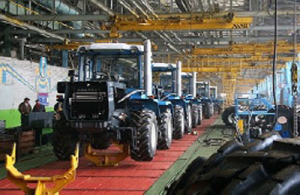Media Enquiries
For media inquiries contact:
+1 202 429 9500
Ukraine: Agricultural Equipment In High Demand
October 22, 2024
Global Insights Hub
Download Arcanum Pulse report.
Russia’s invasion has inflicted about $5.8 billion in damages to Ukraine’s agricultural machinery since 2022, choking Ukrainian agriculture – the country’s most important export sector. Foreign companies can play a critical and mutually beneficial role in rejuvenating Ukrainian agriculture through sales of equipment as well as investment in or partnership with Ukrainian manufacturers. With agricultural products accounting for 41% ($27.8 billion) of Ukraine’s overall exports in 2021, the harm to this sector has been among the most debilitating aspects of Putin’s full-scale invasion. Alongside occupation, minefields, and the destruction of port infrastructure, damage to Ukraine’s agricultural machines – and the factories which produce them – has hamstrung Ukrainian agribusiness and threatened the viability of the Ukrainian economy. At the same time, this hardship presents mutually beneficial opportunities for foreign producers and investors intent on assisting Ukraine’s economy rebound while also making a profit through sales of much-needed equipment, or investment and technical support for Ukraine’s indigenous manufacturing capabilities.
- Ukrainian imports of agricultural equipment sharply declined after the beginning of the invasion in 2022, most likely due to funding shortages and the ongoing risk of damage to the equipment as a result of combat operations. Experts from the Kyiv School of Economics estimate that over 21 percent of Ukraine’s agricultural machinery has been damaged, including up to $1.6 billion worth of tractors alone.
- Others believe that the damage could be even higher: a September 2023 report by Ukraine’s Institute for Agrarian Economics estimated that Russia had damaged or destroyed 35-40 percent of Ukraine’s equipment for “preparing or cultivating soil” and 45-50 percent of the country’s tractors.
- Before the war, Ukraine imported 67 percent of its agricultural machinery, especially from the US and Western Europe, but lack of financing and the persistent risk of damage to equipment have caused a decline in these purchases. UN experts estimated in May 2024 that Ukraine’s production of overall machinery and equipment declined by 57 percent compared to the average between 2019-2021
Looking ahead, agriculture is set to be a priority on the post-war reconstruction agenda for Ukraine, which likely will reinvigorate the country’s demand for foreign equipment to supplement its diminished indigenous manufacturing capabilities. Even in wartime, the country’s agriculture sector has proven its resilience, and Ukraine has remained among the world’s leading exporters of corn, wheat, and sunflower products; already, Ukraine’s agricultural exports are bouncing back, reaching in February 2024 a wartime record of 5.2 million metric tons. With farming set to continue to play a pivotal role in Ukraine’s economy, the country’s long-need for farming equipment is remarkably high—some experts estimate that the restoration of Ukraine’s agriculture sector will require $6.4 billion for farm equipment and machinery.
- In 2022, the sole type of agricultural equipment that was imported at a higher rate than 2021 was plows (up by 37.2%), which were primarily cheap versions purchased from China, indicating that Ukrainian agribusiness has so far relied on temporary, low-cost solutions.
- The United States Commercial Service at the International Trade Administration has a positive long-term view on opportunities for the sale of American-made agricultural equipment to Ukraine.
- Innovative programs have been developed to ensure that even small and medium-sized farms have access to the necessary equipment – for example, OTP Leasing, the largest leasing company in the country, finances 70 percent of the funds needed for leases on agricultural and other equipment, many of which can be sourced from Western companies.
Beyond its potential as an export market for agriculture equipment, Ukraine offers considerable opportunities for manufacturing partnerships and foreign direct investment, with Ukraine’s indigenous producers likely to reap outsized benefits from the post-war boom in demand for agricultural machines. With the Ukrainian government subsidizing the purchase of Ukrainian-made agriculture equipment by 25 percent, domestically-produced machines may eventually outcompete Western ones on price, especially if this sector is supported by Western technology transfers and capital that can help Ukrainian companies cut manufacturing costs and improve the quality of products. Despite the risks of investing in wartime Ukraine—including limited access to war insurance—some Western companies have continued to bet on Ukrainian agriculture. Last April, for example, Germany’s Bayer AG announced that it will spend $65 million upgrading its seed production site near Kyiv.
- Although foreign direct investment in Ukraine is growing, many companies are deterred by the considerable wartime risks, and FDI mostly consists of reinvested earnings by Western companies already operating in Ukraine—of the $2.2 billion of FDI in Ukraine in the first quarter of 2024, almost 70 percent ($1.5 billion) came from reinvested earnings.
- Historically, foreign-made equipment was often preferred by Ukrainian buyers due to its lower costs and/or superiority, but this dynamic may change if Ukraine can improve its manufacturing processes, including through technology transfers from Western companies as part of joint ventures or similar initiatives.
- With access to the right information, foreign investors can mitigate war-associated risks – the Bayer seed production site, for example, is located in the Kvitneve village community, which throughout the war has experienced zero conflict incidents (such as missile strikes), according to Ukrainian government data.

